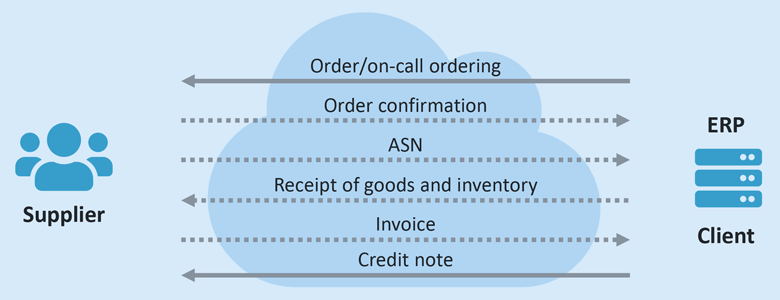Integrating Suppliers with WebEDI

Nowadays, even small businesses can enjoy digital EDI communication with their partners. The solution is WebEDI. Find out how WebEDI has evolved, how it is used, its advantages and how you can use it to drive forward the digital transformation of your supply chain.
From EDI to WebEDI
Back in the 1990s, data was mainly exchanged via ISDN (Integrated Services Digital Network). In order to send information digitally, each partner needed an ISDN connection, a telephone number and appropriate software. This software together with the use of data protocols could be considered an EDI solution.
In order to operate EDI in the 1990s, you therefore needed to set up the software and the necessary protocols on-premises. At the same time, the internet was emerging, and thanks to its http protocol, could be used by the masses.
At the turn of the century, internet technology really matured. This was helped by the further development of Java and the emergence of web frameworks. These made it possible to develop enterprise applications you could operate and manage via the internet. These applications are known as web portals or web applications.
These portals made it considerably easier to distribute programmes because users did not need to install any full-fledged software on their own machines (known as a fat client). Instead, they simply needed a basic internet browser and internet access to use the applications, making their machine a thin client.
A WebEDI Portal is when data is collected via such a portal, transformed into EDI data in the background and sent to an end consumer. We’ll look at this further in the next section. What type of documents are exchanged? Who is a typical user? And what are the current trends in WebEDI?
Using WebEDI
As mentioned above, companies tended to use on-premises solutions for their EDI needs. However, it was never the intention of WebEDI portals to replace on-premises solutions. Instead, WebEDI portals have served to make EDI available to a wider range of companies.
It was expensive to set up an on-premises EDI solution, not to mention resource-heavy in terms of personnel and hardware. Not every company was able to do afford this, so continued to use the traditional communication methods of letter, fax and e-mail to exchange information.
WebEDI portals, however, have given these companies a ‘cheap’ way to do EDI. In a supply chain, generally a WebEDI portal is set up by the customer and made available to business partners such as suppliers, freight forwarders, etc. However, there are also marketplace models (mostly from third-party providers) where customers and suppliers meet at the same level and agree to exchange data. In the cloud movement that emerged in the late 2000s, it has long been standard practice for a customer to outsource a WebEDI solution to specialist companies.
The increasing demand to exchange documents via EDI is being led by the growing need of (end) customers to digitalise their entire supply chain and create more transparency.
- Why not discover more about the challenges in integrating suppliers along the supply chain in par tone of our blog series?
Exchanging documents via WebEDI
If you look at the WebEDI solutions currently available on the market, you will notice that most portals specialise in exchanging two main document types. These are order documents – whether individual orders or on call serial production – and advanced shipping notifications (ASN).
These two document types are the most frequently exchanged in a business relationship. Therefore, it is these it is most useful to digitalise. Of course, it would be lovely to have a full range of digitalised document types. However, this also needs to make economic sense. To put it bluntly, it wouldn’t be worth introducing WebEDI or EDI for a document type which is only exchanged ten times a year.
A further advantage of these document types in that they are standardised via intermediaries such as ODETTE, VDA or UN (EDIFACT) and there are already processes and formats for EDI. Basically, you’re building on an industry standard.
As well as the two document types above, there are some others which are frequently being exchanged over WebEDI:
- order confirmations
- incoming goods receipts and inventory level
- invoices and credit notes

The benefits of WebEDI
Companies must be able to adapt their products flexibly to market requirements and ensure high quality and availability. EDI message exchange is a cornerstone to achieving these goals. And, WebEDI opens this up to partners who do not or cannot have an on-prem EDI solution.
Companies who adopt WebEDI benefit from the following:
- Lower transfer time, as information flows from one partner to another within seconds
- Less data entry, as the information is already in the system and doesn’t need re-entering
- Fewer errors, as information is not entered by hand
- Less paper which means easier, more transparent access to information
- Lower data handling costs as the whole process is more streamlined
Not to mention the direct positive impact on manufacturing and planning, such as:
- Easier to register incoming goods, as the ASNs are already in the system. It would also be possible to introduce a scanner-based system if most delivery documents were digitally available.
- Lower warehouse space required, as transparent planning and a quick turnaround means you don’t need das much stock in reserve.
- Easier to select suppliers for further projects as data on their delivery quality and other key performance indicators are readily available.
For many companies, WebEDI is an important component in digitally transforming their supply chain to remain competitive in the market. However, EDI and WebEDI are not the whole story in digital transforming supply chains. Why not have a look at the next instalment of this supplier integration blog series to find out more?
Thank you for your message
We appreciate your interest in SEEBURGER
Get in contact with us:
Please enter details about your project in the message section so we can direct your inquiry to the right consultant.
Written by: Alex Jende
Alex Jende started his career as a student at SEEBURGER in 2008. After completing his Master's degree in Information Management in 2010, he started full-time as a consultant for logistics solutions at SEEBURGER. His first focus was the realization of international customer projects in the field of automotive logistics. From 2015 he was responsible for the product management of the Logistic Solution Professional and from 2020 additionally for the Supplier Portal and thus the area of WebEDI for supplier connectivity at SEEBURGER. Alex relaxes as often as possible with extensive jogging tours around his home in Leipzig. Most weekends he goes back to his hometown Magdeburg. As a passionate soccer fan, he never misses a game of his club, the 1. FC Magdeburg, along with his family. His favorite way to spend his vacations is hiking in the Alps.





